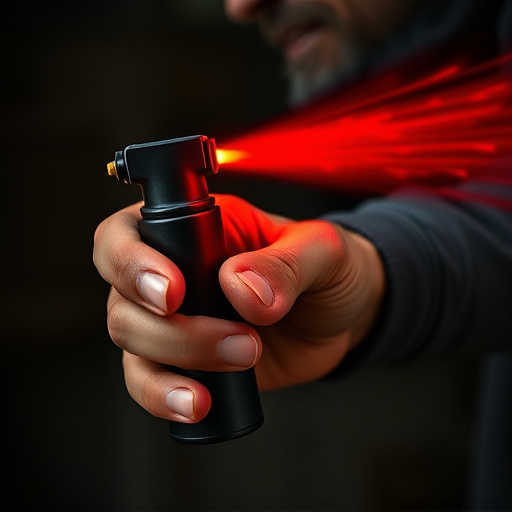Pepper spray removal from skin involves immediate flushing with water (for at least 15 minutes) and using viscous substances to trap remaining particles. Sensitive areas like eyes require specific care, including warm water rinsing for 10 minutes or more. Mild soap can be used if any residue persists. Proper handling and aftercare of pepper spray, including testing in well-ventilated areas, keeping out of reach of children and pets, and regular cleaning, are crucial for safety and effectiveness. Medical attention should be sought if irritation continues or worsens.
Personal protection has become an essential aspect of daily life, especially with concerns around safety and security. One innovative solution gaining traction is capsicum-based personal protection spray, a non-lethal option for self-defence. This article delves into the mechanics of this potent spray, focusing on how it works and offering practical advice on its application and removal. We’ll explore effective techniques for pepper spray removal from skin, highlighting essential precautions and aftercare steps to ensure safety and comfort.
- Understanding Capsicum-Based Personal Protection Spray
- How Pepper Spray Removal From Skin Works
- Effective Techniques for Removing Pepper Spray from the Skin
- Precautions and Aftercare When Using Personal Protection Spray
Understanding Capsicum-Based Personal Protection Spray
Capsicum-based personal protection sprays, often referred to as pepper spray, have gained significant attention for their effectiveness in self-defence situations. This type of spray is designed to cause irritation and disorientation when sprayed into someone’s eyes and respiratory system. The active ingredient, capsaicin, is derived from chili peppers and is responsible for the burning sensation it creates. Understanding how these sprays work and their unique properties is crucial when considering personal protection.
When pepper spray comes into contact with skin or mucous membranes, it can lead to a range of temporary but intense symptoms. These include teary eyes, difficulty breathing, coughing, and a strong, burning sensation. The effects typically subside after a few minutes, but the process of removing pepper spray from the skin is essential for comfort and safety. Proper cleaning techniques are necessary to ensure no residual capsaicin remains, preventing further irritation or potential health risks.
How Pepper Spray Removal From Skin Works
When pepper spray comes into contact with your skin, it’s a complex chemical reaction that occurs. The active ingredient, capsaicin, binds to pain receptors, causing intense irritation and a burning sensation. This is why immediate Pepper Spray Removal From Skin is crucial after exposure.
The process of removing pepper spray from the skin involves flushing the affected area with large amounts of water to dilute the concentration of capsaicin. Using viscous substances like oil or petroleum jelly can also help trap and remove the remaining pepper spray particles. It’s important to remember that proper rinsing and cleaning are essential steps to ensure the skin is free from any residual irritants, providing immediate relief and preventing further discomfort.
Effective Techniques for Removing Pepper Spray from the Skin
When exposed to pepper spray, prompt action is crucial for effective removal from the skin. The first step is to flush the affected area with plenty of clean water for at least 15 minutes. This helps to dilute and wash away the capsaicin oil responsible for the burning sensation. After thorough rinsing, applying a mild soap can help remove any remaining pepper spray residue.
For sensitive areas like eyes, immediate action is essential. Rinse them with clean, warm water for at least 10 minutes, keeping the lids open. Seeking medical attention is advisable if irritation persists or intensifies. Using over-the-counter eye washes or artificial tears can provide temporary relief during the flushing process.
Precautions and Aftercare When Using Personal Protection Spray
When using a capsicum-based personal protection spray, it’s crucial to take certain precautions to ensure safety and effectiveness. Always test the spray in a well-ventilated area before use, and keep it out of reach of children and pets. In case of accidental contact with eyes or skin, immediately flush with plenty of water for at least 15 minutes. If irritation persists, seek medical advice.
Aftercare is an essential aspect of using personal protection spray. Remove any contaminated clothing and wash thoroughly with mild soap and warm water. Disinfect the affected area and surrounding surfaces to prevent cross-contamination. Keep the spray can securely closed when not in use, and store it in a cool, dry place away from direct sunlight. Regularly check expiration dates and replace the spray as needed for optimal performance.
In conclusion, capsicum-based personal protection spray offers an effective means of self-defence, but understanding how pepper spray removal from skin works is crucial for both safety and aftercare. By employing proven techniques to remove pepper spray from the skin, users can mitigate discomfort and ensure proper precautions are taken. Remember that effective management of exposure involves quick action and specific methods, making it essential to be prepared with knowledge and resources when facing such situations.
